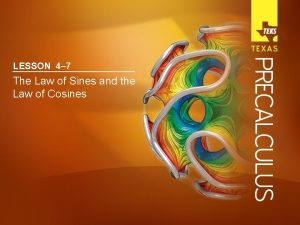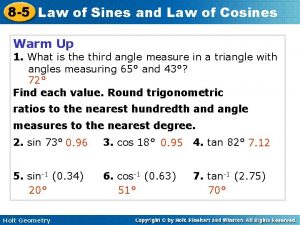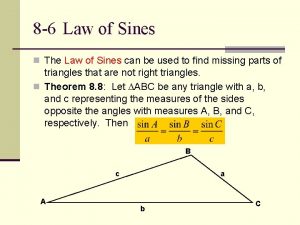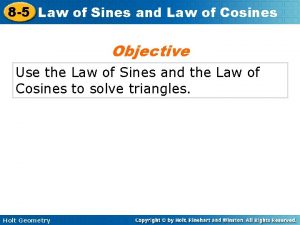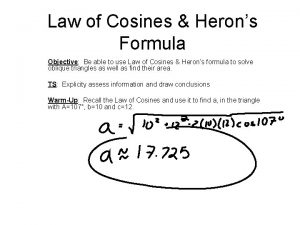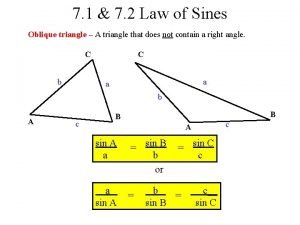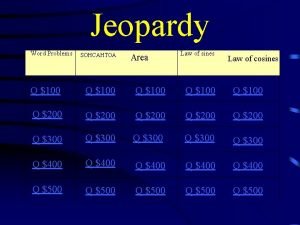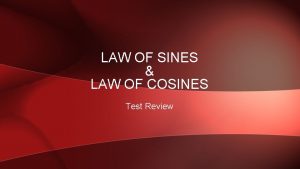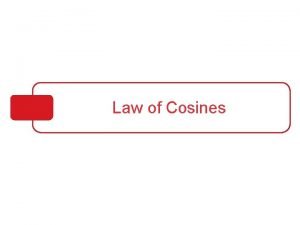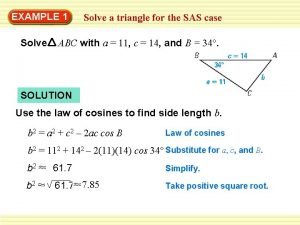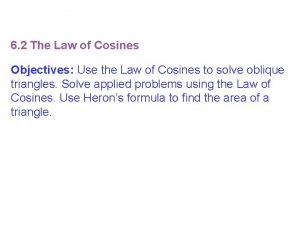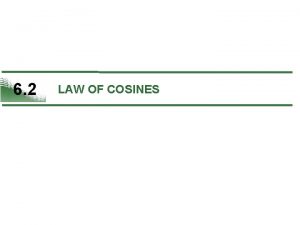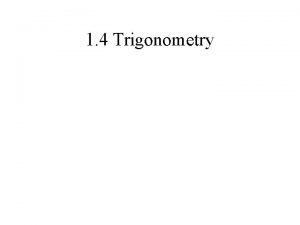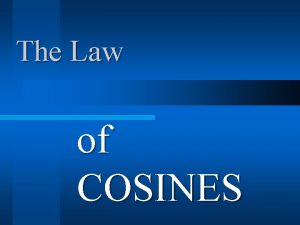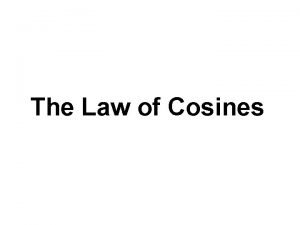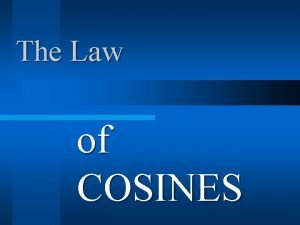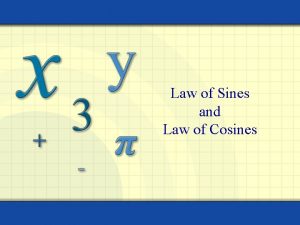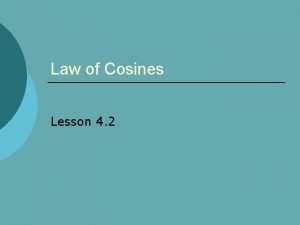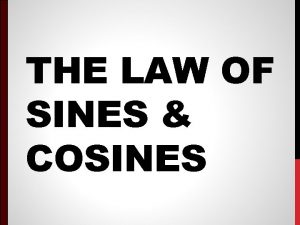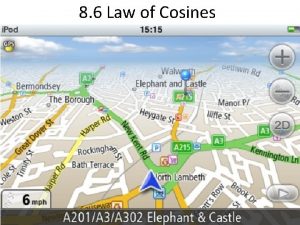10 2 The Law of Cosines and Area














- Slides: 14

10. 2 The Law of Cosines and Area Formulas • SAS or SSS forms a unique triangle • Triangle Side Restriction – In any triangle, the sum of the lengths of any two sides must be greater than the length of the remaining side. Copyright © 2007 Pearson Education, Inc. Slide 10 -1

10. 2 Derivation of the Law of Cosines Let ABC be any oblique triangle drawn with its vertices labeled as in the figure below. The coordinates of point A become (c cos B, c sin B). Copyright © 2007 Pearson Education, Inc. Slide 10 -2

10. 2 Derivation of the Law of Cosines Point C has coordinates (a, 0) and AC has length b. This result is one form of the law of cosines. Placing A or C at the origin would have given the same result, but with the variables rearranged. Copyright © 2007 Pearson Education, Inc. Slide 10 -3

10. 2 The Law of Cosines In any triangle ABC, with sides a, b, and c, Copyright © 2007 Pearson Education, Inc. Slide 10 -4

10. 2 Using the Law of Cosines to Solve a Triangle (SAS) Example Solve triangle ABC if A = 42. 3°, b = 12. 9 meters, and c = 15. 4 meters. Copyright © 2007 Pearson Education, Inc. Slide 10 -5

10. 2 Using the Law of Cosines to Solve a Triangle (SAS) B must be the smaller of the two remaining angles since it is opposite the shorter of the two sides b and c. Therefore, it cannot be obtuse. Caution If we had chosen to find C rather than B, we would not have known whether C equals 81. 7° or its supplement, 98. 3°. Copyright © 2007 Pearson Education, Inc. Slide 10 -6

10. 2 Using the Law of Cosines to Solve a Triangle (SSS) Example Solve triangle ABC if a = 9. 47 feet, b =15. 9 feet, and c = 21. 1 feet. Solution We solve for C, the largest angle, first. If cos C < 0, then C will be obtuse. Copyright © 2007 Pearson Education, Inc. Slide 10 -7

10. 2 Using the Law of Cosines to Solve a Triangle (SSS) Verify with either the law of sines or the law of cosines that B 45. 1°. Then, Copyright © 2007 Pearson Education, Inc. Slide 10 -8

10. 2 Summary of Cases with Suggested Procedures Oblique Triangle Case 1: SAA or ASA Suggested Procedure for Solving 1. 2. Oblique Triangle Case 2: SSA Copyright © 2007 Pearson Education, Inc. Find the remaining angle using the angle sum formula (A + B + C = 180°). Find the remaining sides using the law of sines. Suggested Procedure for Solving This is the ambiguous case; 0, 1, or 2 triangles. 1. Find an angle using the law of sines. 2. Find the remaining angle using the angle sum formula. 3. Find the remaining side using the law of sines. If two triangles exist, repeat steps 2 and 3. Slide 10 -9

10. 2 Summary of Cases with Suggested Procedures Oblique Triangle Case 3: SAS Suggested Procedure for Solving 1. 2. 3. Oblique Triangle Case 4: SSS Suggested Procedure for Solving 1. 2. 3. Copyright © 2007 Pearson Education, Inc. Find the third side using the law of cosines. Find the smaller of the two remaining angles using the law of sines. Find the remaining angle using the angle sum formula. Find the largest angle using the law of cosines. Find either remaining angle using the law of sines. Find the remaining angle using the angle sum formula. Slide 10 -10

10. 2 Area Formulas • The law of cosines can be used to derive a formula for the area of a triangle given the lengths of three sides known as Heron’s Formula If a triangle has sides of lengths a, b, and c and if the semiperimeter is Then the area of the triangle is Copyright © 2007 Pearson Education, Inc. Slide 10 -11

10. 2 Using Heron’s Formula to Find an Area Example The distance “as the crow flies” from Los Angeles to New York is 2451 miles, from New York to Montreal is 331 miles, and from Montreal to Los Angeles is 2427 miles. What is the area of the triangular region having these three cities as vertices? (Ignore the curvature of the earth. ) Solution Copyright © 2007 Pearson Education, Inc. Slide 10 -12

10. 2 Area of a Triangle Given SAS • The area of any triangle is given by A = ½bh, where b is its base and h is its height. Area of a Triangle In any triangle ABC, the area A is given by any of the following: Copyright © 2007 Pearson Education, Inc. Slide 10 -13

10. 2 Finding the Area of a Triangle (SAS) Example Find the area of triangle ABC in the figure. Solution We are given B = 55°, a = 34 feet, and c = 42 feet. Copyright © 2007 Pearson Education, Inc. Slide 10 -14
 4-7 the law of sines and the law of cosines
4-7 the law of sines and the law of cosines 8-5 practice law of sines
8-5 practice law of sines 8-6 the law of sines and law of cosines
8-6 the law of sines and law of cosines 8-5 law of sines and law of cosines
8-5 law of sines and law of cosines Law of cosines formula
Law of cosines formula Trigonometry maze version 4 answer key
Trigonometry maze version 4 answer key Dot product rules
Dot product rules Law of sines and cosines word problems
Law of sines and cosines word problems Ambiguous case example
Ambiguous case example Law of sines and cosines test
Law of sines and cosines test Law of cosines sss
Law of cosines sss Solve triangle sas
Solve triangle sas Law of cosines sss
Law of cosines sss Law of cosines sas
Law of cosines sas Law of cosines vectors
Law of cosines vectors
